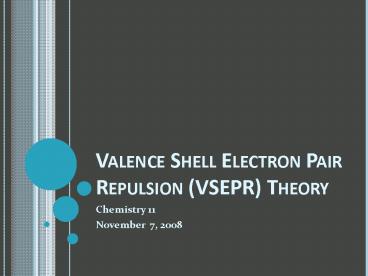Valence Shell Electron Pair Repulsion (VSEPR) Theory - PowerPoint PPT Presentation
1 / 15
Title:
Valence Shell Electron Pair Repulsion (VSEPR) Theory
Description:
Lone pair-lone pair (LP-LP) repulsion is considered to be stronger than ... Finished? Assign VSEPR shapes to the homework sheet (questions 1-5) from last class. ... – PowerPoint PPT presentation
Number of Views:440
Avg rating:3.0/5.0
Title: Valence Shell Electron Pair Repulsion (VSEPR) Theory
1
Valence Shell Electron Pair Repulsion (VSEPR)
Theory
- Chemistry 11
- November 7, 2008
2
Vsepr Theory
- What is it?
- Model developed to predict the shapes of
molecules - Remember
- Atoms are bound together by electron pairs called
bonding pairs - These can be single (one pair e- single bond)
or multiple (2 pair e- double bond 3 pair e-
triple bond) - Some atoms in a molecule can also have pairs of
electrons not involved in bonding called lone
pairs or non-bonded pairs
3
VSEPR Theory
- Why are we concerned with the shape of molecules?
- Will help us later when we discuss polarity
- What causes molecules to take on a different
shape? - Electron pairs (bonding pairs and lone pairs) are
negatively charged and will repel each other - These pairs of electrons tend to occupy positions
around the atom that minimize repulsions and
maximize the distance of separation between them
4
- Three types of repulsions take place in an atom
- Lone Pair Lone Pair (LP-LP)
- Lone Pair Bonding Pair (LP-BP)
- Bonding Pair Bonding Pair (BP-BP)
- Lone pairs occupy more space than bonding
electron pairs - Double bonds occupy more space than a single bond
5
- A molecule must avoid these repulsions to remain
stable. - When repulsion cannot be avoided, the weaker
repulsion (i.e. the one that causes the smallest
deviation from the ideal shape) is preferred. - Lone pair-lone pair (LP-LP) repulsion is
considered to be stronger than the lone
pair-bonding pair (LP-BP) repulsion, which in
turn is stronger than the bonding pair-bonding
pair (BP-BP) repulsion. - LP-LP gt LP-BP gt BP-BP
6
Things to Remember
- When assigning a VSEPR Shape to a molecule, we
focus on the central atom and the bonding pairs
or lone pairs associated with it - Ex. CO2
- Electron pairs are considered to exist in a
domain
- Domains can be made up of
- A lone pair
- A single bond
- A double bond
- A triple bond
- Thus, all are considered to be one electron pair
Domain
7
Steps to Determine VSEPR Shape
- Draw the Lewis structure of the molecule
- Determine the central atom (the least
electronegative) - Determine the number of bonding pairs
- Determine the number of lone pairs
- Consult the VSEPR chart to find the shape
8
VSEPR Chart
9
Number of Electron Groups Name of Molecular Shape Type of Electron Pairs Shape Example
2 Linear All Bonding Pairs CO2
3 Trigonal Planar All Bonding Pairs CH2O
4 Tetrahedral All Bonding Pairs CH4
4 Pyramidal 3 Bonding Pairs 1 Lone Pair NH3
4 Bent 2 Bonding Pairs 2 Lone Pairs H20
10
- Carbon Dioxide CO2
- As a Lewis Dot diagram
- Has two electron pairs - two sets of double
bonds two bonding pairs - Creates a LINEAR shape according to VESPR
11
- Methanal CH2O
- As a Lewis Dot diagram
- Has three electron pairs - three bonding pairs
and no lone pairs - Note Only has three bonding pairs because the
double bond is considered to be one bonding pair! - Creates a TRIGONAL PLANAR shape according to VESPR
12
- Methane CH4
- As a Lewis Dot diagram
- Has four electron pairs - four bonding pairs and
no lone pairs - Creates a TETRAHEDRAL shape according to VESPR
13
- Ammonia NH3
- As a Lewis Dot diagram
- Has four electron pairs - three bonding pairs
and one lone pair - Creates a PYRAMIDAL shape according to VESPR
14
- Water H2O
- As a Lewis Dot diagram
- Has four electron pairs - two bonding pairs and
two lone pairs - Creates a BENT shape according to VESPR
15
Practice
- Draw the VSEPR shape for each of these molecules
- HCN
- CCl4
- SI2
- H3O
- CH2F2
- AsCl3
- NO2
- CH3F
- NF3
- CCl2F2
- NCl3
- SO42-
- COCl2
- NO2-
- NH4
Finished? Assign VSEPR shapes to the homework
sheet (questions 1-5) from last class. ?































